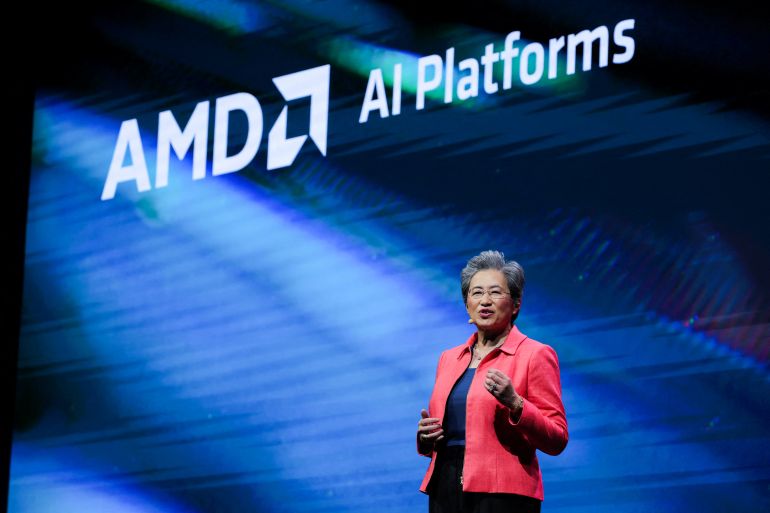Science
US Partners with AMD to Develop $1 Billion in Supercomputing Power

The United States Department of Energy (DOE) has entered into a significant partnership with Advanced Micro Devices (AMD) to develop two advanced supercomputers, with a total investment of $1 billion. This collaboration aims to address a range of complex scientific challenges, including advancements in nuclear power, cancer treatment, and national security. The announcement was made by Energy Secretary Chris Wright and AMD CEO Lisa Su, as reported by the Reuters news agency.
The two supercomputers are part of a strategic initiative to enhance the United States’ capacity for large-scale data processing, which is critical for conducting increasingly sophisticated experiments. Secretary Wright emphasized that these systems will “supercharge” scientific discoveries in areas prioritized by the government, including nuclear and fusion energy technologies, defense strategies, and pharmaceutical developments.
Accelerating Scientific Discovery
Wright noted the need for advanced computational power to replicate fusion, the process that fuels the sun. This involves compressing light atoms within a plasma gas under extreme heat and pressure to release vast amounts of energy. He stated, “We’ve made great progress, but plasmas are unstable, and we need to recreate the centre of the sun on Earth.” The Secretary expressed optimism that the new supercomputers could significantly speed up research, potentially leading to practical applications for harnessing fusion energy within the next two to three years.
Moreover, the supercomputers are expected to play a crucial role in managing the United States’ nuclear arsenal and expediting drug discovery processes. Wright mentioned the potential for transforming many cancers from terminal diagnoses into manageable conditions within the next five to eight years, highlighting the vital role of advanced computing in this endeavor.
Details of the Supercomputers
The first supercomputer, named Lux, is set to be operational within the next six months. It will incorporate AMD’s MI355X artificial intelligence (AI) chips, along with central processing units (CPUs) and networking chips also manufactured by AMD. The system is a collaborative effort involving AMD, Hewlett Packard Enterprise (HPE), Oracle Cloud Infrastructure, and Oak Ridge National Laboratory (ORNL).
According to Su, the deployment of Lux represents the fastest implementation of a computer of this scale she has witnessed. “This is the speed and agility that we wanted for the US AI efforts,” she commented. ORNL Director Stephen Streiffer remarked that Lux will provide approximately three times the AI capacity of existing supercomputers.
The second computer, known as Discovery, is anticipated to be delivered in 2028 and operational by 2029. This more advanced system will utilize AMD’s MI430 series of AI chips, which are specifically designed for high-performance computing. Streiffer acknowledged the significant advancements expected from Discovery but refrained from estimating the exact increase in computational power.
The DOE will host both supercomputers, while AMD and its partners will manage the financial investment and provide the necessary technology. This collaboration is envisioned as the first of many similar partnerships between the DOE and private industry, a move that underscores the importance of innovation in national scientific endeavors.
As of 12:15 PM in New York (16:15 GMT), AMD’s stock had risen by 0.7 percent, reflecting positive market sentiment regarding this ambitious project.
-

 Politics2 weeks ago
Politics2 weeks agoDallin H. Oaks Assumes Leadership of Latter-day Saints Church
-

 Sports2 weeks ago
Sports2 weeks agoSteve Kerr Supports Jonathan Kuminga After Ejection in Preseason Game
-

 Science2 weeks ago
Science2 weeks agoChicago’s Viral ‘Rat Hole’ Likely Created by Squirrel, Study Reveals
-

 Lifestyle2 weeks ago
Lifestyle2 weeks agoKelsea Ballerini Launches ‘Burn the Baggage’ Candle with Ranger Station
-

 Lifestyle2 weeks ago
Lifestyle2 weeks agoDua Lipa Celebrates Passing GCSE Spanish During World Tour
-

 Entertainment2 weeks ago
Entertainment2 weeks agoZoe Saldana Advocates for James Cameron’s Avatar Documentary
-

 Business2 weeks ago
Business2 weeks agoTyler Technologies Set to Reveal Q3 2025 Earnings on October 22
-

 Health2 weeks ago
Health2 weeks agoRichard Feldman Urges Ban on Menthol in Cigarettes and Vapes
-

 World2 weeks ago
World2 weeks agoD’Angelo, Iconic R&B Singer, Dies at 51 After Cancer Battle
-

 Business2 weeks ago
Business2 weeks agoMLB Qualifying Offer Jumps to $22.02 Million for 2024
-

 Health2 weeks ago
Health2 weeks agoCommunity Unites for Seventh Annual Mental Health Awareness Walk
-

 Sports2 weeks ago
Sports2 weeks agoPatriots Dominate Picks as Raiders Fall in Season Opener









